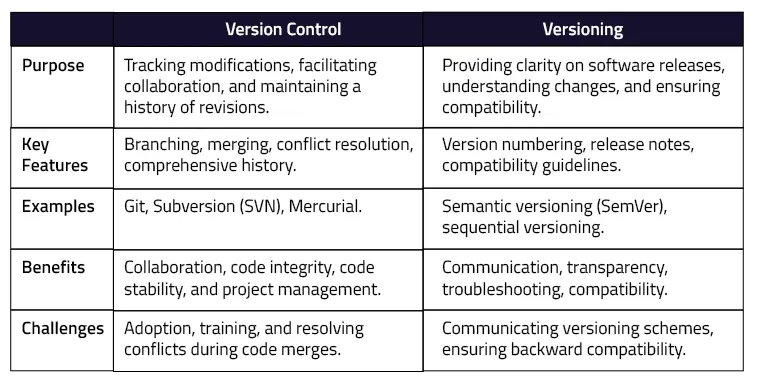In the fast-changing world of software development, successfully handling different versions of code and software releases has become extremely important. The global software development market is expected to exceed $1.3 trillion by the end of 2023, underscoring the scale and importance of effective version control and versioning practices. These practices are critical for maintaining code integrity, encouraging developer collaborations, and assuring seamless upgrades.
Although we frequently use the terms version control and versioning interchangeably, they perform distinct functions in software development. According to industry surveys, about 85% of software development teams use version control systems. This widespread usage emphasizes its significance in allowing developers to track changes, interact effectively, and manage complicated projects while minimizing code disputes and guaranteeing code stability. Furthermore, good versioning practices improve user happiness and software uptake by clarifying the importance of software releases and assuring backward compatibility.
In the competitive software development world, software professionals may optimize their development workflows, improve collaboration, and provide great software solutions by knowing the difference between version control and versioning.
In this blog, we will go deeper into the complexities of version control and versioning, diving into their features, benefits, and complimentary roles in the software development lifecycle.
What is Version Control?
Version control, commonly referred to as source control, is a method of controlling modifications to software code or files continually. It enables developers to track changes, collaborate productively, and retain a history of revisions. Version control systems (VCS) serve as the process’s backbone.
VCSs have two types: centralized and distributed. Centralized VCS uses a central repository to store all file versions, whereas distributed VCS allows developers to have their local repositories for greater flexibility and autonomy. Git, Subversion (SVN), and Mercurial are some common version control technologies.
What is Versioning?
On the other hand, versioning is the process of labeling and numbering software releases. It offers a formal method for identifying different iterations or upgrades to a software product. Versioning assists developers and users in understanding the significance of each update or release, the changes made, and compatibility with earlier versions.
Versioning approaches vary, with semantic versioning (SemVer) being one of the most extensively used. MAJOR.MINOR.PATCH is the versioning method used by SemVer. Each number shows the significance of the modifications. Backward-incompatible modifications are indicated by major versions, backward-compatible additions are indicated by minor versions, and backward-compatible bug fixes are indicated by patch versions.
Difference between Version Control and Versioning
Consider their fundamental goals better to distinguish between version control and versioning. Version control is primarily concerned with managing changes to code and files, allowing developers to collaborate, revert to earlier versions, and keep a complete history. It emphasizes the practice of tracking changes and enabling smooth team collaboration.
On the other hand, versioning focuses on assigning relevant labels or numbers to software releases. It assists users and developers in distinguishing between versions, comprehending the relevance of changes, and determining compatibility. Versioning is a communication tool that clarifies the evolution of the software product.

Version Control and Versioning: Advantages and Challenges
Version control and versioning both provide significant advantages in the software development process. Version control promotes a methodical approach to collaboration, decreases disagreements during code merges, and boosts productivity. It enables teams to work on different features or branches at the same time, optimizing the development workflow.
Versioning, on the other hand, promotes openness and dialogue. It allows users to understand the evolution of the software, makes troubleshooting easier, and ensures backward compatibility. When upgrading to new releases, versioning assists users in making informed decisions and supports a disciplined approach to software release management.
It is difficult to implement version control and versioning practices. Providing effective training and adoption of version control tools across the organization is critical. Effective communication about versioning methods and compatibility is critical for a positive user experience. Maintaining backward compatibility while adding new features necessitates careful planning and documentation.
Let’s look at a real-world example to demonstrate the value of version control and versioning. Consider a development team working on a web app. Version control enables them to work on many features simultaneously, branch out the code, and integrate changes seamlessly. It assists them in tracking errors, reverting to prior versions as needed, and maintaining code quality throughout the development lifecycle.
As an example, suppose the team deploys version 1.0 of their app. Users can understand the relevance of the update by referring to the version number. Assume the team adds a function in version 1.1. Because the major version remains the same, users can assume backward compatibility.

Conclusion
Ultimately, version control and versioning serve unique functions in software development. Version control is concerned with controlling changes, fostering cooperation, and maintaining a complete modification history. On the other hand, versioning serves to signify the significance of software releases, assuring clarity and compatibility.
Software development teams can expedite workflows, improve communication, and create high-quality software products by employing strong version control practices and using a disciplined approach to versioning. Understanding the differences between version control and versioning is essential for reaping both benefits.
Version control and versioning are essential components of an effective DevOps workflow. DevOps promotes a culture of continuous integration, delivery, and deployment by emphasizing collaboration and integration between development and operations teams. Providing a common repository of code, allowing code reviews, and enabling automated testing and deployment, proper version control practices enable DevOps teams to collaborate.
DevOps training can help software developers learn version control and versioning practices. DevOps training gives people the skills and knowledge they need to use version control systems successfully, use branching methods, resolve conflicts, and adopt best practices in versioning. Organizations may achieve shorter release cycles, increased collaboration, and higher software quality by adopting DevOps principles and training in their operations.
Learn DevOps with Cognixia
Enroll in Cognixia’s DevOps Training to strengthen your career. Take a step to boost your career opportunities and prospects. Get into our DevOps certification course that is hands-on, collaborative, and instructor-led. Cognixia is here to provide you with a great online learning experience, to assist you in expanding your knowledge through entertaining training sessions, and to add considerable value to your skillset in today’s competitive market. Individuals and the corporate workforce can both benefit from Cognixia’s online courses.
Regardless of your familiarity with IT technology and procedures, the DevOps Plus course gives a complete look at the discipline, covering all critical ideas, approaches, and tools. It covers the fundamentals of virtualization, its advantages, and the different virtualization tools that play a vital part in both learnings & implementing the DevOps culture, starting with a core introduction to DevOps. You’ll also discover the DevOps tools like Vagrant, Containerization, VCS, and Docker and Configuration Management using Chef, Puppet, Salt Stack, and Ansible.
This DevOps course covers intermediate to advanced aspects. Get certified in DevOps and become acquainted with concepts such as the open-source monitoring tool Nagios, including its plugins, and its usage as a graphical user interface. The Advanced DevOps fundamentals and Docker container clustering leveraging Docker Swarm & Kubernetes in the CI/CD Pipeline Automation are thoroughly discussed.
Our online DevOps training covers the following concepts –
- Introduction to DevOps
- GIT: Version Control
- Maven
- Docker – Containers
- Puppet for configuration management
- Ansible
- Nagios: Monitoring
- Jenkins – Continuous Integration
- Docker Container Clustering using Docker Swarm
- Docker Container Clustering using Kubernetes
- Advanced DevOps (CI/CD Pipeline Automation)
Prerequisites for DevOps training
This course requires just a basic grasp of programming & software development. These requirements are helpful but not compulsory because this all-inclusive training is aimed at newcomers and experienced professionals.




